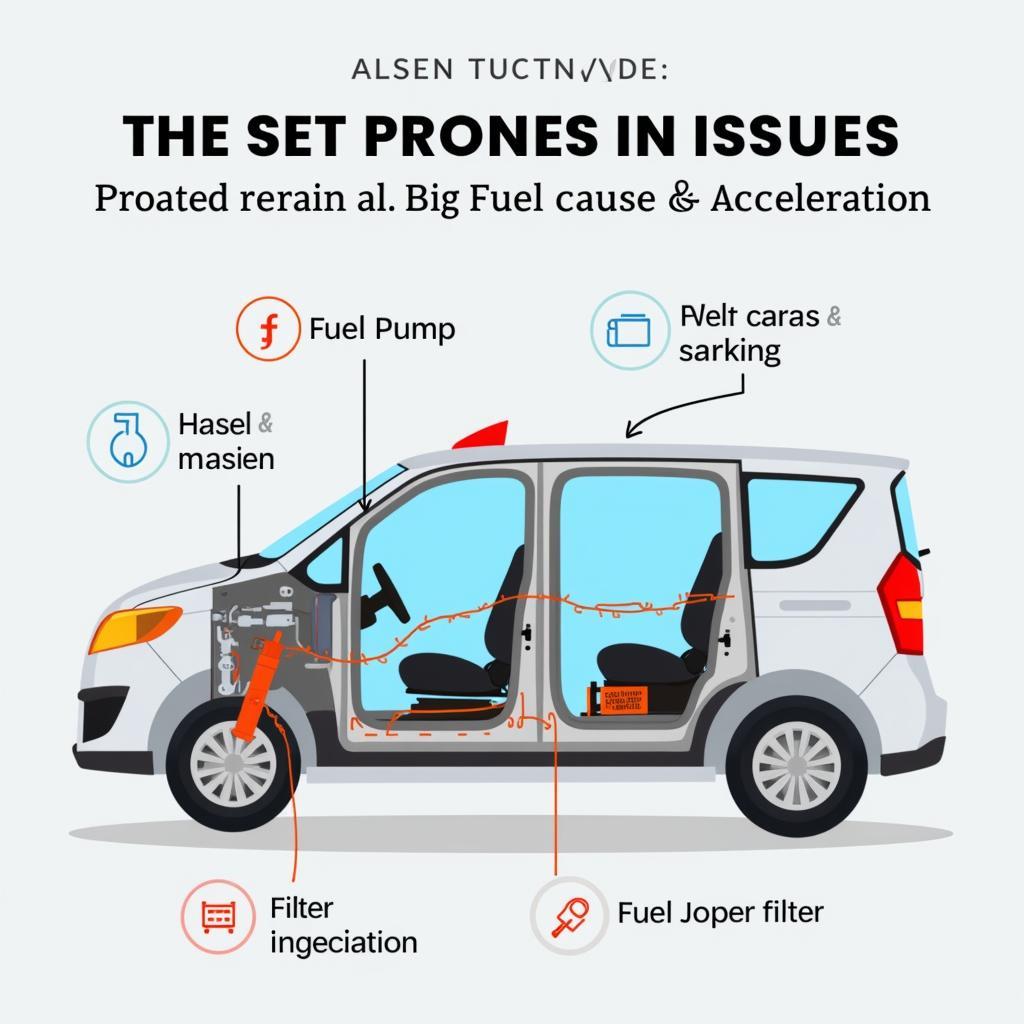When you step on the gas and nothing happens, it can be a frustrating and even scary experience. This article addresses this common car problem, offering a step-by-step guide to diagnosing and potentially fixing the issue. We’ll explore various causes, from simple fixes to more complex mechanical problems, empowering you to take control of the situation and get back on the road.
After checking the seemingly obvious things like whether the car is in neutral or if the emergency brake is engaged, there are several reasons why your car might not respond when you press the accelerator. These range from simple issues like a loose gas cap to more complex problems requiring professional attention. Let’s delve into some of the most common culprits.
Common Causes of No Acceleration
Fuel System Issues
One of the most common reasons for a lack of acceleration is a problem within the fuel system. This can manifest in several ways:
- Empty Fuel Tank: It might seem obvious, but sometimes the simplest explanation is the right one. Make sure you have enough fuel!
- Clogged Fuel Filter: A dirty fuel filter restricts fuel flow to the engine. This can lead to sluggish acceleration or, in severe cases, no acceleration at all.
- Faulty Fuel Pump: The fuel pump is responsible for delivering fuel from the tank to the engine. If it fails, the engine won’t receive the necessary fuel to run.
- Fuel Injector Problems: Fuel injectors spray fuel into the engine cylinders. Clogged or malfunctioning injectors can prevent proper fuel delivery.
Electrical Problems
Electrical issues can also cause acceleration problems:
- Dead Battery: A dead battery can prevent the engine from starting, let alone accelerating.
- Alternator Issues: A failing alternator won’t recharge the battery properly, eventually leading to a dead battery and a non-responsive accelerator.
- Faulty Sensors: Modern cars rely on various sensors to control engine performance. A malfunctioning sensor, such as the throttle position sensor or mass airflow sensor, can disrupt the fuel-air mixture and hinder acceleration.
- Wiring Problems: Damaged or corroded wiring can interrupt the flow of electricity to essential engine components.
Transmission Problems
Problems with the transmission can also prevent the car from accelerating:
- Low Transmission Fluid: Just like engine oil, transmission fluid is crucial for proper operation. Low fluid levels can cause slippage and a lack of acceleration.
- Transmission Slippage: This occurs when the transmission fails to engage gears properly, resulting in a loss of power to the wheels.
Engine Problems
In some cases, the problem lies within the engine itself:
- Clogged Air Filter: A restricted airflow due to a clogged air filter can suffocate the engine, leading to poor performance and a lack of acceleration.
- Spark Plug Issues: Worn-out or fouled spark plugs can prevent the engine from igniting the fuel-air mixture effectively.
- Vacuum Leaks: Leaks in the engine’s vacuum system can disrupt the air-fuel ratio and cause various performance issues, including poor acceleration.
- Mechanical Failure: More severe engine problems, such as a blown head gasket or damaged pistons, can also lead to a complete loss of power.
 Car Fuel System Components and Potential Issues
Car Fuel System Components and Potential Issues
Troubleshooting Steps
- Check the Obvious: Ensure the car isn’t in neutral or park and that the emergency brake is disengaged.
- Check the Fuel Gauge: Confirm you have enough fuel.
- Listen for Unusual Noises: Any strange sounds from the engine or transmission could indicate a problem.
- Check Warning Lights: Pay attention to any illuminated warning lights on the dashboard, such as the check engine light.
- Try Starting the Car: If the car won’t even start, the problem might be a dead battery or a faulty starter.
- Check the Gas Cap: Ensure the gas cap is tightly sealed. A loose or damaged gas cap can disrupt the fuel system’s pressure.
 Dashboard Warning Lights Indicating Potential Car Problems
Dashboard Warning Lights Indicating Potential Car Problems
If you’ve performed these basic checks and the problem persists, it’s best to seek professional help. A qualified mechanic can diagnose the issue accurately and recommend the appropriate repairs.
For further assistance with starting issues, you might find this article helpful: my car wont start what can be the problem.
What if My Car Won’t Accelerate?
This section specifically addresses situations where the car starts but won’t accelerate.
- Check for Transmission Problems: A common symptom of transmission problems is a car that starts but won’t move or accelerate.
- Inspect the Throttle Cable (if applicable): Older cars with a mechanical throttle cable may experience issues if the cable is loose, broken, or sticking.
- Check the Throttle Position Sensor (TPS): A faulty TPS can send incorrect signals to the engine control module, affecting acceleration.
“A faulty TPS is often overlooked but can be a major culprit when a car won’t accelerate,” says John Miller, a seasoned automotive technician with over 20 years of experience. “It’s a relatively simple part to replace, but its impact on performance can be significant.”
Conclusion
When you step on the gas and nothing happens, it can be a sign of various underlying issues, ranging from simple fuel problems to complex engine or transmission failures. By following the troubleshooting steps outlined in this article, you can begin to pinpoint the cause and determine the best course of action. Remember, if you’re unsure or the problem persists, consulting a qualified mechanic is always the safest option. Don’t hesitate to connect with AutoTipPro at +1 (641) 206-8880 or visit our office at 500 N St Mary’s St, San Antonio, TX 78205, United States, for expert advice and assistance.
You might also find this resource valuable if you’re experiencing acceleration problems: when a car won’t accelerate what is the problem.





Leave a Reply